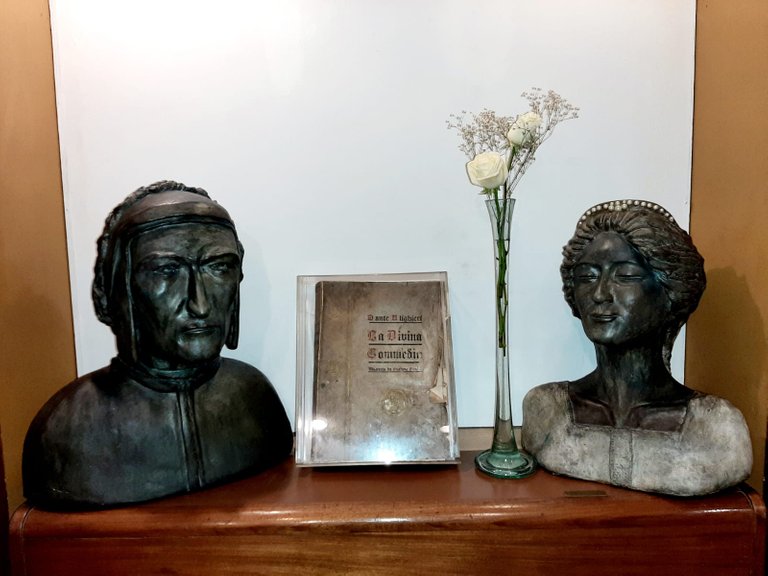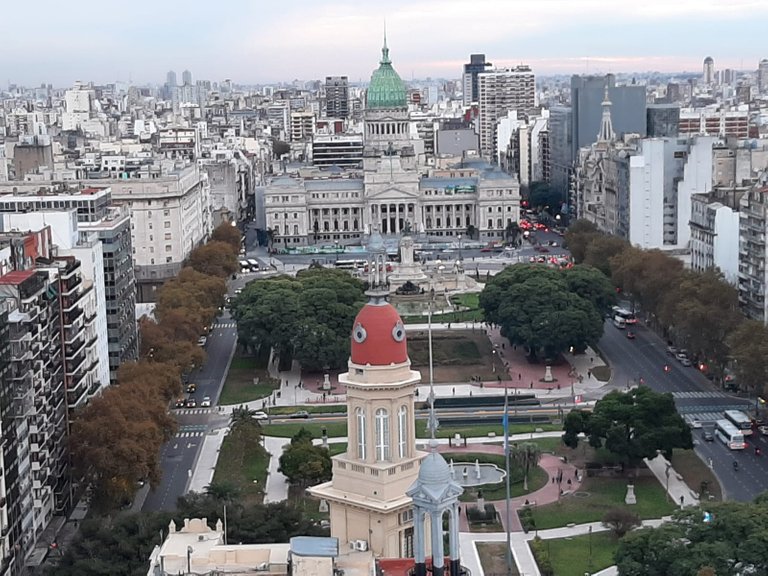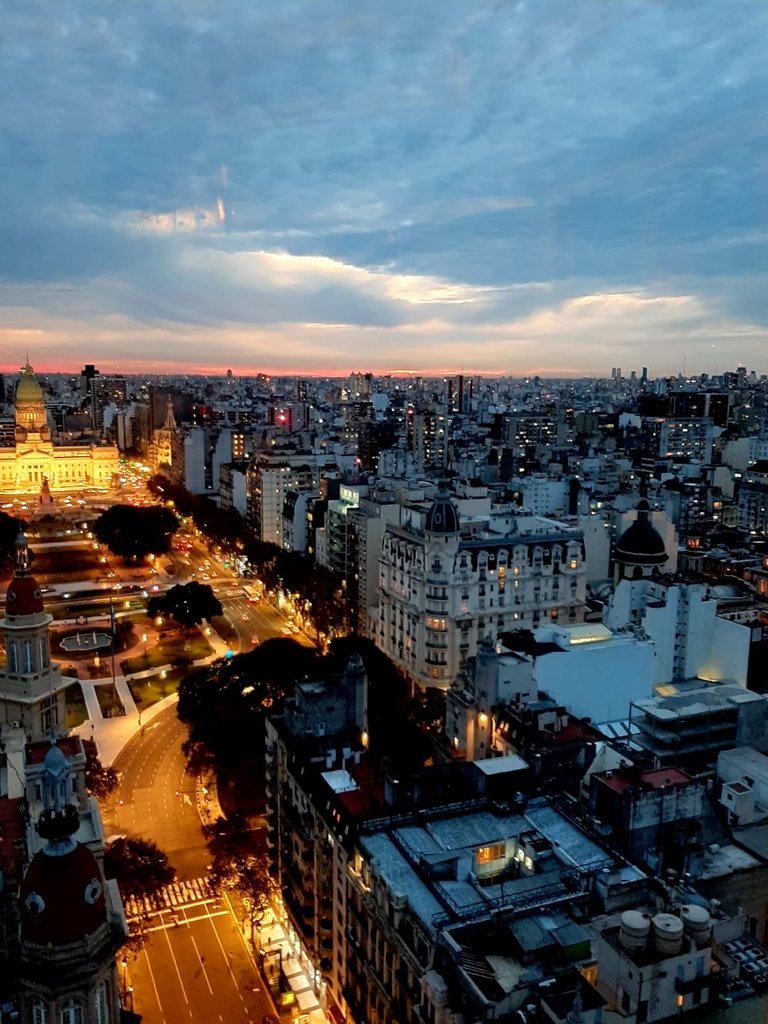Palacio Barolo

Gracias a la visita de una amiga de mi esposa residente de Pamplona, capital de Navarra y mundialmente conocida por los Sanfermines, una fiesta religiosa en honor a San Fermín que se realiza cada año entre el 6 y el 14 de julio y donde se desarrollan los tradicionales encierros de toros, estamos paseando y disfrutando de Buenos Aires en varios de sus aspectos relevantes, principalmente los culturales.

Ayer concurrimos a una visita guiada al Palacio Barolo, una construcción centenaria, de la época en que esta gran ciudad rebosaba de prosperidad y era una de las capitales preferidas por los europeos para vivir, visitarla y embellecerla gracias a sus arquitectos e ingenieros que venían a mostrar sus conocimientos.

La construcción es atípica ya que mezcla varios estilos arquitectónicos diferentes pero principalmente es un homenaje a la Divina Comedia, la obra cumbre de Dante Alighieri, De hecho, su cúpula es la única con un estilo indio propio de la región y representa la unión tántrica entre Dante y Beatriche, los protagonistas de la obra.

El arquitecto Mario Palanti de origen italiano, era un estudioso de la Divina Comedia y cuando se lo contrató para desarrollar el edificio, no dudó en colocar una gran cantidad de referencias a la obra de Dante, lo que le otorga un valor adicional al gran trabajo arquitectónico en si.

La división general del Palacio Barolo se compone de tres partes que representan, al igual que en la obra de Dante, el infierno, el purgatorio y el paraíso, posee nueve bóvedas de acceso que identifican los nueve pasos de iniciación y las nueve jerarquías infernales, el faro de la cúpula representa los nueve coros angelicales y así las referencias continúan hasta formar una representación total y absoluta del poema épico.

El edificio fue declarado patrimonio nacional en 1997 y se encuentra en total actividad, ocupado principalmente por oficinas comerciales de distintas empresas y su mantenimiento es impecable.

Por supuesto existe la posibilidad de conocerlo mediante una visita guiada que lleva a los ocasionales turistas y vecinos por un paseo que incluye la reseña histórica, ornamentaciones y citas en latín, oficinas emblemáticas, pasillos, locales, salas de música y otras atracciones que culminan en la gran cúpula donde se puede tener una vista de 360° de la gran ciudad y también observar el funcionamiento del faro que en otros tiempos ayudaba a los navegantes a ubicarse en el enorme estuario del Río de la Plata.

Según cuenta una leyenda con ciertos visos de certeza, los constructores albergaron la idea peregrina de traer los restos de Dante Alighieri para que este lugar fuera su morada definitiva. No pudo ser por supuesto, sin embargo la obra hubiera merecido un premio tan grande como ese.
Barolo Palace
Thanks to the visit of a friend of my wife who lives in Pamplona, the capital of Navarra and known worldwide for the Sanfermines, a religious festival in honor of San Fermín that takes place every year between July 6 and 14 and where the traditional bull running, we are walking and enjoying Buenos Aires in several of its relevant aspects, mainly the cultural ones.
Yesterday we went on a guided tour of the Barolo Palace, a century-old construction from the time when this great city was brimming with prosperity and was one of the favorite capitals for Europeans to live in, visit, and beautify thanks to its architects and engineers who came to show your knowledge.
The construction is atypical since it mixes several different architectural styles but mainly it is a tribute to the Divine Comedy, the masterpiece of Dante Alighieri. In fact, its dome is the only one with an Indian style typical of the region and represents the tantric union between Dante and Beatriche, the protagonists of the work.
The architect Mario Palanti, of Italian origin, was a scholar of the Divine Comedy and when he was hired to develop the building, he did not hesitate to place a large number of references to the work of Dante, which gives additional value to the great work architecture itself.
The general division of the Barolo Palace is made up of three parts that represent, as in Dante's work, hell, purgatory, and paradise, it has nine access vaults that identify the nine initiation steps and the nine infernal hierarchies, the lighthouse on the dome represents the nine angelic choirs and thus the references continue until they form a total and absolute representation of the epic poem.
The building was declared national heritage in 1997 and is fully active, occupied mainly by commercial offices of different companies and its maintenance is impeccable.
Of course, there is the possibility of getting to know it through a guided tour that takes the occasional tourists and residents on a tour that includes a historical review, ornamentation and Latin quotes, emblematic offices, corridors, venues, music rooms, and other attractions that culminate in the great dome where you can have a 360° view of the big city and also observe the operation of the lighthouse that in other times helped navigators to locate themselves in the enormous estuary of the Río de la Plata.
According to a legend with certain overtones of certainty, the builders harbored the strange idea of bringing the remains of Dante Alighieri so that this place would be his final home. It could not be, of course, however, the work would have deserved a prize as big as that.
Héctor Gugliermo
@hosgug